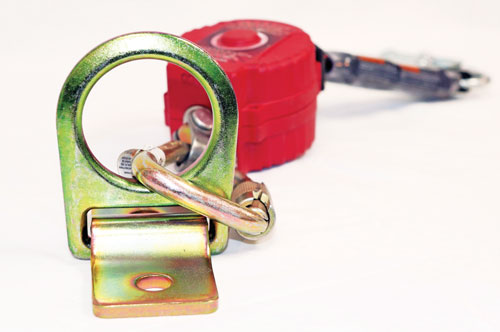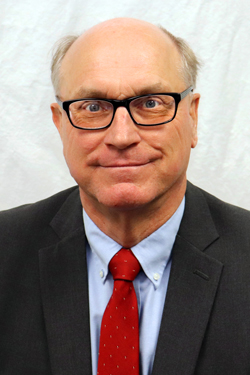Proper Anchorage prevents deaths from falls
 An MSA D-Plate™ Anchorage Connector Assembly is shown connected to a personal fall arrest system. Proper installation and testing of Anchorage hardware can prevent deaths from falls in manufacturing facilities. (CANCO photo)
An MSA D-Plate™ Anchorage Connector Assembly is shown connected to a personal fall arrest system. Proper installation and testing of Anchorage hardware can prevent deaths from falls in manufacturing facilities. (CANCO photo)
4 years, 7 months ago
By Tim Seibert, P.E.
President, Carl A. Nelson & Company

President
The latest annual statistics published by the U.S. Bureau of Labor Statistics show 4,160 injuries and 27 deaths due to falls to a lower level in the manufacturing sector. While these are low when compared to the construction sector at 13,770 injuries and 320 deaths, they are still significant and relatively easy to manage in the manufacturing environments.
According to OSHA General Industry standards, employees on a walking-working surface with an unprotected side or edge that is four feet or more above a lower level need to be protected from falling.1 In the building code, which would be applicable to new construction, the requirement is two-feet, six-inches.2 During construction this requirement is six feet.3 In general industry, this protection is usually provided by using guardrail systems but there are situations, even in general industry, where personal fall arrest systems are necessary. These situations include unguarded roofs, open hoist ways, elevated hoist access doors, elevated truck and rail access and equipment maintenance access.
Personal fall arrest systems consist of a body harness, Anchorage, and connector.4 Anchorages are a secure point of attachment5 for a personal fall arrest system and can be designed under two different standards.
The first compliance path is for non-engineered Anchorages that, in the judgment of a competent person, will support a design load of 5,000 pounds for each employee attached.6 A competent person is a person who is capable of identifying existing and predictable hazards in any personal fall protection system or any component of it, as well as in their application and uses with related equipment; and who has authorization to take prompt, corrective action to eliminate the identified hazards.7
The second compliance path for Anchorages is to be designed by a Qualified Person and requires a safety factor of at least two for the system.8 A Qualified Person possesses a recognized degree, certificate, or professional standing, or who by extensive knowledge, training, and experience has successfully demonstrated the ability to solve or resolve problems.9 Licensed engineers are considered Qualified Persons. Personal fall arrest systems must limit the arresting force on the employee to 1,800 pounds.10 With the required safety factor of two, the ultimate load for an Anchorage under this compliance path for one person is 3,600 pounds.
OSHA does not require Anchorages to be load-tested initially upon installation or periodically. We have some clients who voluntarily require testing of Anchorages either initially or periodically or both. If tested, we recommend that Anchorages be load tested at 125% of the 1,800-pound load, which is 2,250 pounds. If Anchorages are designed for an ultimate load of 3,600 pounds, they cannot be load tested at that load without risk of failure. Where feasible, we recommend testing the Anchorages by picking up a concrete block with a manual hoist attached to the anchor point that has a certified weight of 2,250 pounds. We recommend that a dated photo of the suspended load be part of the testing documentation.
Whether you test or not, we recommend that you create a log of the Anchorages in the building and number each Anchorage with a visible placard that can uniquely identify each Anchorage, and then store the initial engineering certification and the test documentation, if completed, under this numbering system.
Footnotes
- 29 CFR Part 1910.28(b)(1)(i)
- 2015 International Building Code Section 1015.2
- 29 CFR Part 1926.501(b)(1)
- 29 CFR Part 1910.140(b)
- 29 CFR Part 1910.140(b)
- 29 CFR Part 1910.140(c)(13)(i)
- 29 CFR Part 1910.140(b)
- 29 CFR Part 1910.140(c)(13)(ii)
- 29 CFR Part 1910.140(b)
- 29 CFR Part 1910.140(d)(1)(i)
ABOUT THE AUTHOR
Tim Seibert, P.E., joined Carl A. Nelson & Company in 1994 as a project manager, advanced to vice president of construction and in 2007, was elevated to the position of president. He is a graduate of Iowa State University with a bachelor of science degree in construction engineering, holds a master’s degree in business administration from the University of Illinois-Champaign/Urbana, and is a licensed professional engineer in Iowa and Illinois.
•••
Carl A. Nelson & Company is available to help manufacturing and other industrial clients address code-related issues in their facilities. Call (319) 754-8415, or email Ellen McCulley AIA LEED-AP NCARB at canco@carlanelsonco.com.